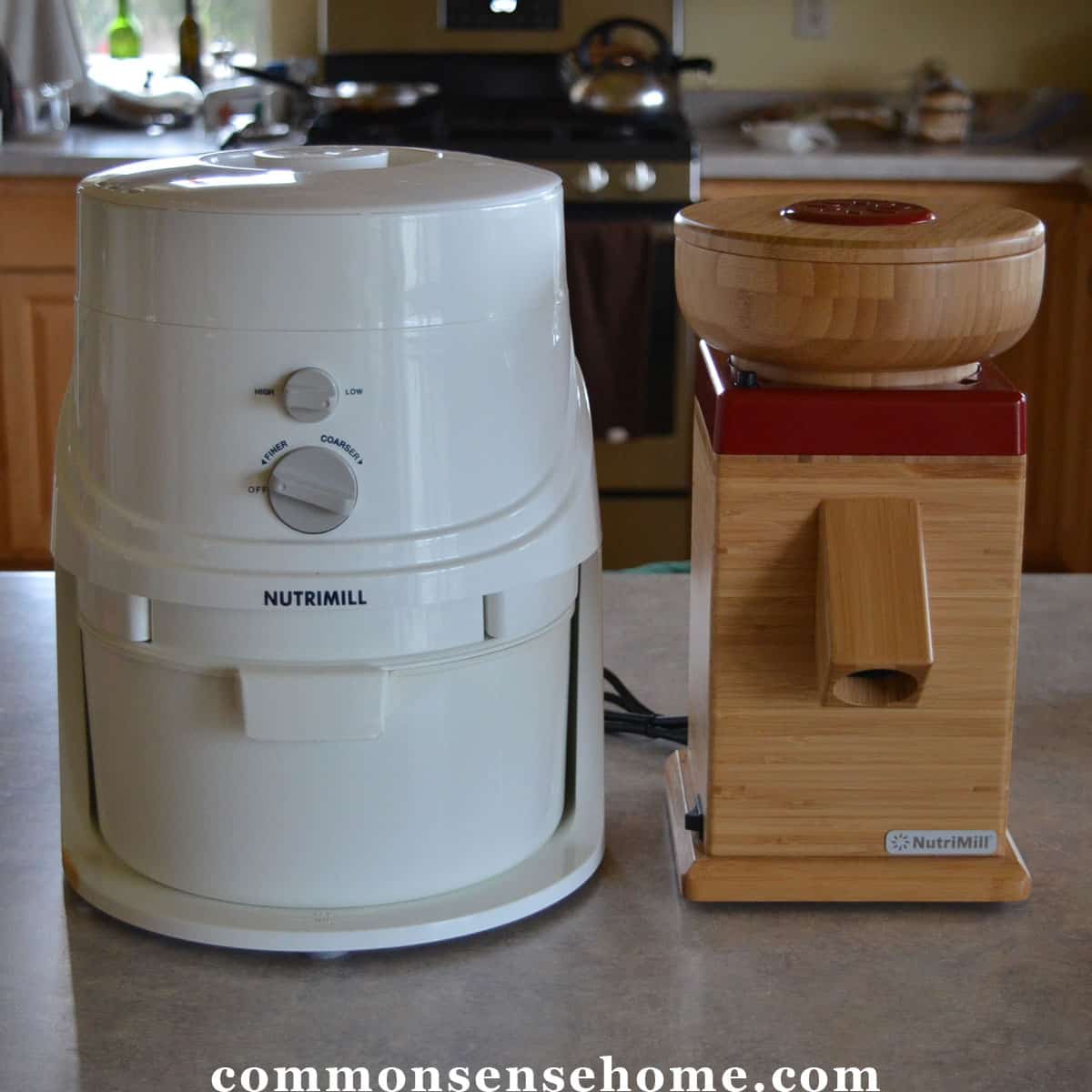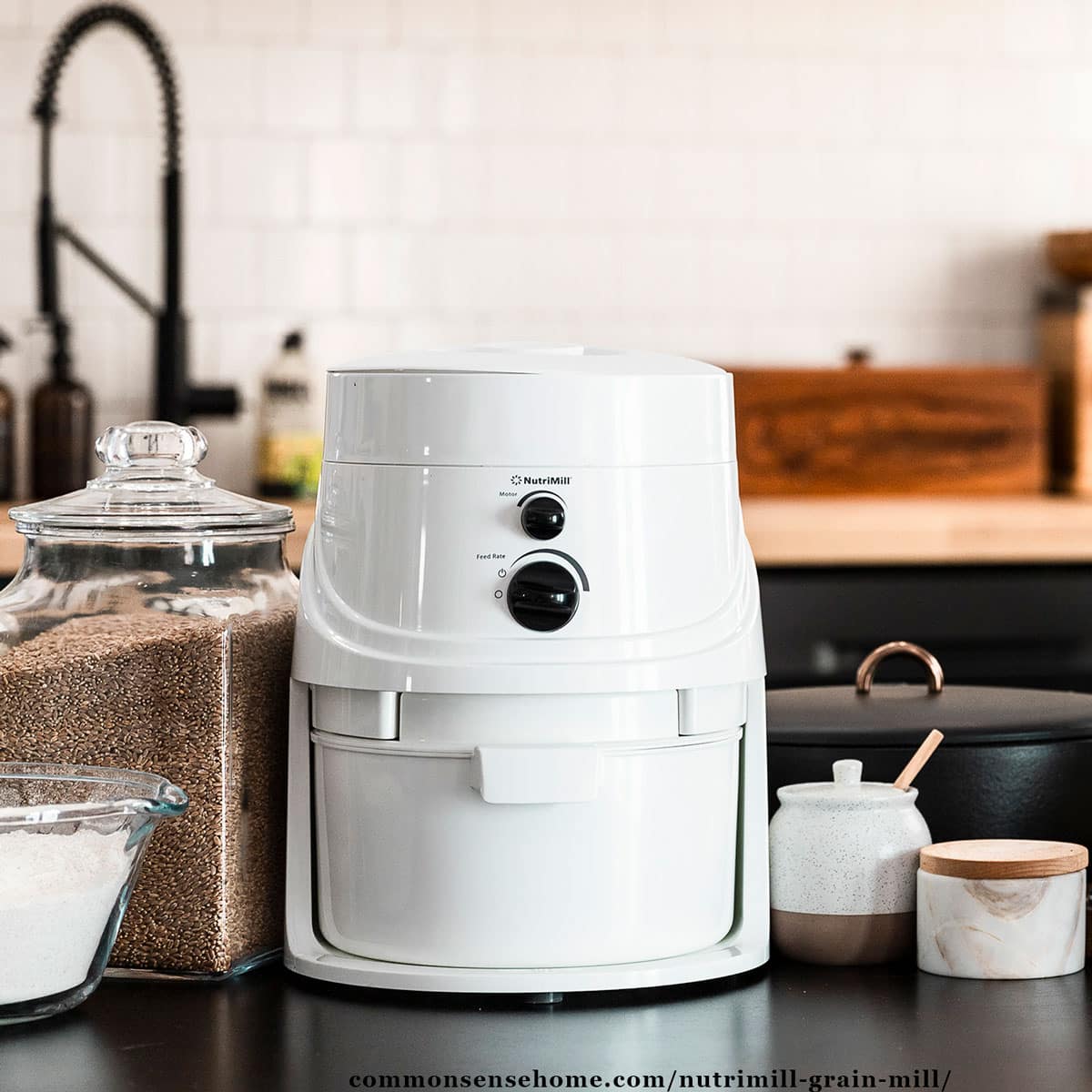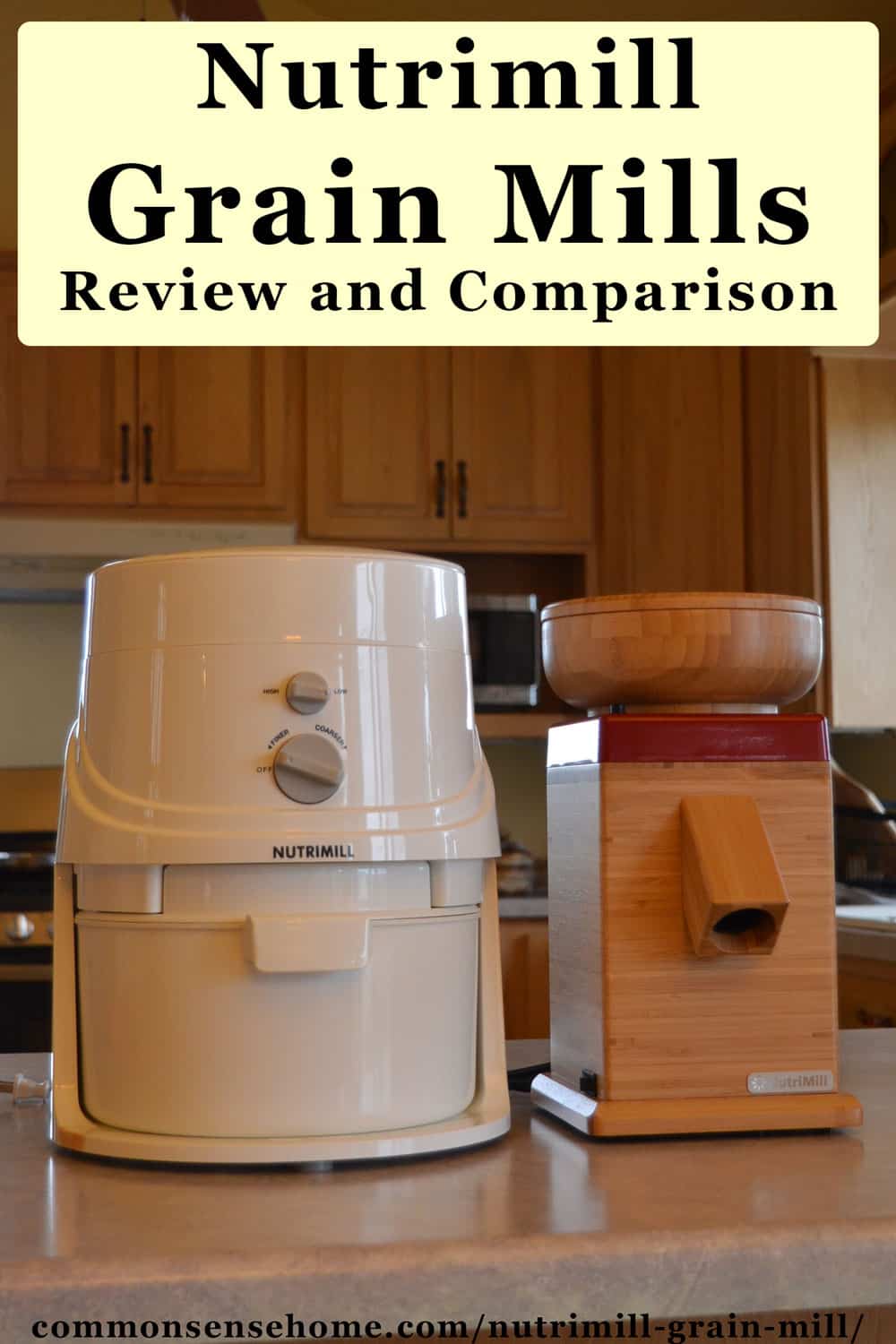Nutrimill Grain Mill (Which one should I get?)
This post may contain affiliate links. Read my full disclosure here.
I’ve had a Nutrimill Classic grain mill for around 10 years, and recently got a chance to try their their Harvest grain mill.
We’ll review and compare Nutrimill grain mills to help you decide which one is right for you. Both mills allow you to grind fresh, whole grain flour whenever you’re ready to bake, and grind at low heat to preserve nutrients.

Table of contents
Classic Grain Mill
I’ve had my NutriMill Classic Grain Mill for over 10 years and it is still going strong. (The company has been selling them for over 20 years.)
The Classic uses a high speed impact chamber (also called a micronizer) with stainless steel milling heads to create flour from grains and beans. Just load the hopper with up to 12 cups of grain, turn it on, and grind up to 20 cups of finished flour all at once.

Use the Nutrimill Classic grain mill to grind:
Wheat (both hard and soft), oat groats (dehulled oats), rice, triticale, kamut, spelt, dry beans, lentils, dent (field) corn, popcorn, dried sweet corn, split peas, buckwheat, barley, rye, millet, teff, quinoa, amaranth, sorghum, dried mung beans, and soybeans. It will also grind dried, minimally-sprouted grain.
Do not use it for:
Herbs, spices, oilseeds like flax, chopped chestnuts or fibrous materials.
There are two knobs on front, one for motor speed and one for texture control. Choose coarsely milled grains for hot cereal, or slow down the speed and select fine flour for baking.
The NutriMill Classic Grain Mill comes with a limited lifetime warranty to be free of manufacturing defects in materials and workmanship. It is manufactured in South Korea.
Nutrimill Harvest Grain Mill
The NutriMill Harvest grain mill is smaller, measuring 7″ W x 7″ D x 13″ H. With a durable, eco friendly housing made of bamboo and your choice of trim color, this unit makes an attractive addition to any kitchen.

The 450 watt motor and corundum milling stones let you grind a wide range of non-oily grains, beans, and legumes, including:
Kamut, spelt, barley, farro, rye, soft wheat, hard wheat, triticale, emmer, einkorn, dried sweet corn, oat groats, white rice, brown rice, teff, sorghum, millet, buckwheat, quinoa, amaranth, lentils, chickpeas, garbanzo beans, baby lima beans, mung beans, black beans, navy beans, split peas, pinto beans, soybeans
Do not use it to mill: Chia seeds, sesame seeds, flax seeds, sunflower seeds, popcorn, tapioca, coffee beans, hemp nuts, nuts, sugar, dates/raisins, poppy seeds, herbs & spice, chilies, goji berries, sprouted grains and beans that are not completely dry.
Would you like to save this?
NOTE: Your Harvest grain mill is not going to tackle popcorn and dent corn. You need the Classic Nutrimill for hard corns.
I love how simple the Harvest is to use and to clean. You use the texture control knob on top to get the full range of grinds. Turn clockwise for finer flour, counter-clockwise for more course.
To clean the unit, use the simple lock hopper remover button on the front left of the machine and turn the bowl counter-clockwise. This gives you access to the millstone below, which you brush clean with the included brush.
The NutriMill Harvest Grain Mill comes with a 5 year warranty, and is designed and assembled in the USA.
Which Nutrimill Grain Mill should I get?
All the mills are good, so which one you should buy depends on how you want to use your mill.
The Classic is louder than the Harvest. They sound similar to a vacuum cleaner.
If you want cornmeal, you need to use the Classic. For a mill that looks great on the kitchen counter and is super easy to clean, get the Harvest. If you do a lot of bulk baking, opt for the Classic, as the Harvest has a small grain bowl.
How much does a Nutrimill cost?
At the time of this writing, Nutrimill grain mills range in price from around $250 to $320. I found the best pricing on the Nutrimill website.
The Classic is less expensive, while the Harvest has a higher price point. The Harvest has milling stones and bamboo housing, while the Classic has stainless steel heads and plastic housing. If you are on a tight budget you might consider one of the NutriMill Refurbished Grain mills.
Related Posts
You may find our other articles helpful:
- Nutrimill Artiste Mixer Review
- Home Grain Mills – Comparison of Manual Grain Grinders for the Home
- Bulk Grain – Where to Get It, How to Store It
- Preparedness Storage – Finding Room and Keeping it Safe and Sound
- How to Store Flour Long Term
- Prepping Food Storage – Top 10 Foods to Stockpile

This article is by Laurie Neverman. She has a BS in Math/Physics and MS in Mechanical Engineering with an emphasis in renewable energy. Laurie and her family live in a “concrete bunker” (ICF home) with a permaculture food forest, greenhouses, and three types of solar. They “walk the talk” of preparedness by living a more self-reliant lifestyle.



How do you clean grinding wheels in the classic mill grinder. Wouldn’t you want to clean it after beans or corn?
They suggest that you mill a small amount of other grain to clear any residue and discard, if needed. It doesn’t seem that much is retained within the unit, but if you’d prefer full access to the grinding surfaces, I’d opt for the Harvest.
How well do they work without electricity? (Which is likely when it will be needed)
Strangely, electric appliances require electricity to operate, so these will not work during a power outage. That’s why I use mine for regular baking when I want fresh ground flours.
For grain mills that operate without power, please see the Comparison of Manual Grain Mills. “Manual” means that they operate without electricity.
Thank you for this informative article. I have read it several times over the past year or so. I finally had some extra money to invest in purchasing a Nutrimill and I am so excited to try it out!
Can I grind eikcorn with the classic nutrimill?
Yes, any sort of wheat berries should work well, including more traditional varieties.
I have never milled anything before so I still have a couple of questions.
The Classic and Plus have 1200 watts and the Harvest has 450 watts. I know grain capacity is different. But will one grind as well as the other?
Also the Harvest has milling stones and the others have milling heads. Is that why it is not to be used to mill popcorn? Do you have to be more careful with stones?
The Plus has ‘whisper mill technology’ compared to classic. How does the Harvest compare?
Thanks, Laurie, for all you do to help and encourage us.
The Classic and Plus have more power, so will more readily produce a finer flour than the Harvest with harder grains or legumes. With the Harvest, if you want to get the flour extra fine, you may need to rough mill, then mill it again. The Classic and Plus will produce a finer flour on the first pass, if desired. (One pass through the Harvest with wheat berries works just fine for me for baking bread, but if someone needed it extra fine for pastry flour, it might take twice through.)
The Harvest doesn’t have quite as much power as the Classic and Plus, and popcorn is hard (as is dent or flint corn). The Harvest can mill dried sweet corn, but not popcorn, dent, or flint corn.
Out of curiosity, I tried some of our dent corn in the Harvest. It made a ton of noise and sounded like it wanted to self destruct. The kernels got banged up, but didn’t grind. I ended up opening it up and taking them out. The steel impact grinding and higher power of the Classic and Plus is needed for tougher stuff. I was able to mill rough milled cornmeal into finer cornmeal with the Harvest.
The Harvest is in between the Classic and Plus as far as noise. Quieter than the Classic, slightly louder than the Plus. I don’t have a Plus, but I would compare the Classic and Harvest to a vacuum cleaner. I usually use the Harvest when I want to grind up a smaller batch of something for a recipe, and use the Classic when I want to grind up enough flour to store some in the freezer for later use.
I’ll fill the hopper of the Classic, then set it up in my laundry room and close the door and let it run. When it’s done, the pitch changes, and I come back and shut it off. It’s all self contained, so the flour stays in the unit and not all over the room.
One word of warning – do make sure the flour container is completely tucked into the base of the Classic before milling. One time early on, I thought I had it in place, but it was unseated by about a half inch. I came back to find a layer of flour in a circle around the mill. Whoops! I never made that mistake again.